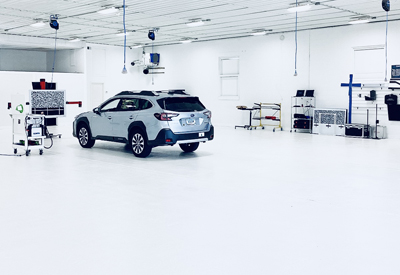Mike clarifies how existing body shops, most of which just don’t have the right space and conditions to do this work accurately, should bring it "in house."
I’ve been a proponent---here in this column and elsewhere---in collision repair businesses working to conduct more ADAS calibration, resets and reprogramming in-house. One of the members of my Spartans groups recently told me he had some concerns about that view, and he had some valid points I thought were worth addressing here.
Let me start by saying I still believe shops should do more of their ADAS work themselves, for several reasons. Clearly, it’s a potential---and growing---profit center. But more importantly, it gives you more control over the process. It can reduce cycle time issues caused when work is sublet. And most importantly, it better ensures the work is being done properly---for the safety of your customers and to reduce your shop’s liability.
That said, Andy Tylka pointed out there are some real challenges to bringing more ADAS “in-house” I didn’t fully spell out. Andy owns multiple body shops in the Midwest, is the current treasurer on the Society of Collision Repair Specialists’ board of directors, and is co-owner of Midwest ADAS, stand-alone calibration centers serving body shops in Indiana and Illinois.
Andy’s concern with my position about bringing ADAS in-house is it’s just not something many---if not most---shops have the facility to do under the same roof in which they are performing collision repair and refinishing. And he’s right about that. So let me clarify what I’m saying.
First, bringing ADAS work in-house involves so much more than just buying some equipment. You need to get the training required, for example. Some automakers, like Toyota/Lexus, offer hands-on technician training in ADAS work. I-CAR is offering training as well. But the key is you can’t just think you can just take somebody off the street and start doing this work without the right training.
Second, you need to have the right equipment. To the best of my knowledge, no automakers, other than Lucid and Rivian, have approved any aftermarket solutions for calibrations. So until that happens, until the OEM engineers have signed off on an aftermarket solution, I stand by my position that you need to be using factory scan tools, targets and equipment for all ADAS work. The precision this work requires makes that an absolute must.
Third---and this was one of the key points Andy pointed out I failed to mention---is you have to have the right space and environmental conditions within your facility to do this work accurately. Most existing body shops just don’t, which limits their ability to bring this work “in-house.”
All of the automakers, for example, spell out their space requirements for ADAS calibrations. While it varies, you generally will need a minimum between 2,000 and 4,000 square feet of space. That’s space with no obstacles---columns or poles, or even toolboxes. Some shops think they can re-engineer the calibrations to offset or compensate for their space. “I only need this much space on the left rear of the car because I'm only doing a blind spot monitor calibration in the left rear.” That’s not accurate. You have to have the specified space on all sides of the vehicle to do consistent, accurate ADAS work.
The floor has to been precisely level; if there’s a drain in the floor, that’s generally an indication that floor will not be level enough for accurate ADAS calibration work. Again, what qualifies as a "level enough" floor varies by automaker, but they all provide those specifications. A slope of even just a couple millimeters beyond the specification can have a tenfold impact on that calibration. Very few existing body shops have a level enough floor for calibration work.
Controlled, consistent and dimmable lighting is equally important. If your shop has skylights or windows or overhead doors open during calibrations, all those variances in lighting can impact the accuracy of ADAS work. The presence of metal, the glare of the floor or anything hanging on the walls also can impact calibrations.
Given all this, I want to clarify that when I say shops should be working toward bringing more of this work “in-house,” that generally doesn’t mean trying to do it in their existing shop. The clients of ours I see doing this most successfully are developing other facilities specifically for this work, sometimes as separate businesses from their shop---dedicated buildings, employees, equipment and training for this work.
As I said, the key upside for doing this is ensuring the work is being done correctly. With no offense to dealerships, many of them are not doing correctly the calibration work body shops are subletting to them---often because they don’t have the space and environmental conditions needed. Andy shared with me one such story.
“We had an educational session at one of our facilities right after we opened it, and we had more than a dozen adjusters there from three insurance companies, along with representatives from other shops, dealerships and even an automaker there,” Andy told me. “That morning we had received a vehicle that had been calibrated elsewhere. We checked it, and the automatic emergency braking was off by two- or three-and-a-half degrees. This was a car that had been returned to the customer as calibrated. The car wasn’t telling the customer there were any issues with it. But the radar was off by several degrees and pointed up in the air. So we had a perfect example of why this work needs to be done right, in the right facility.”
I want to thank Andy for pointing out that when I say shops should be doing more of this work themselves, I need to clarity that doesn’t necessarily mean “in-house.” They have to be able to do it with the precision needed to do it correctly.










Mike Anderson